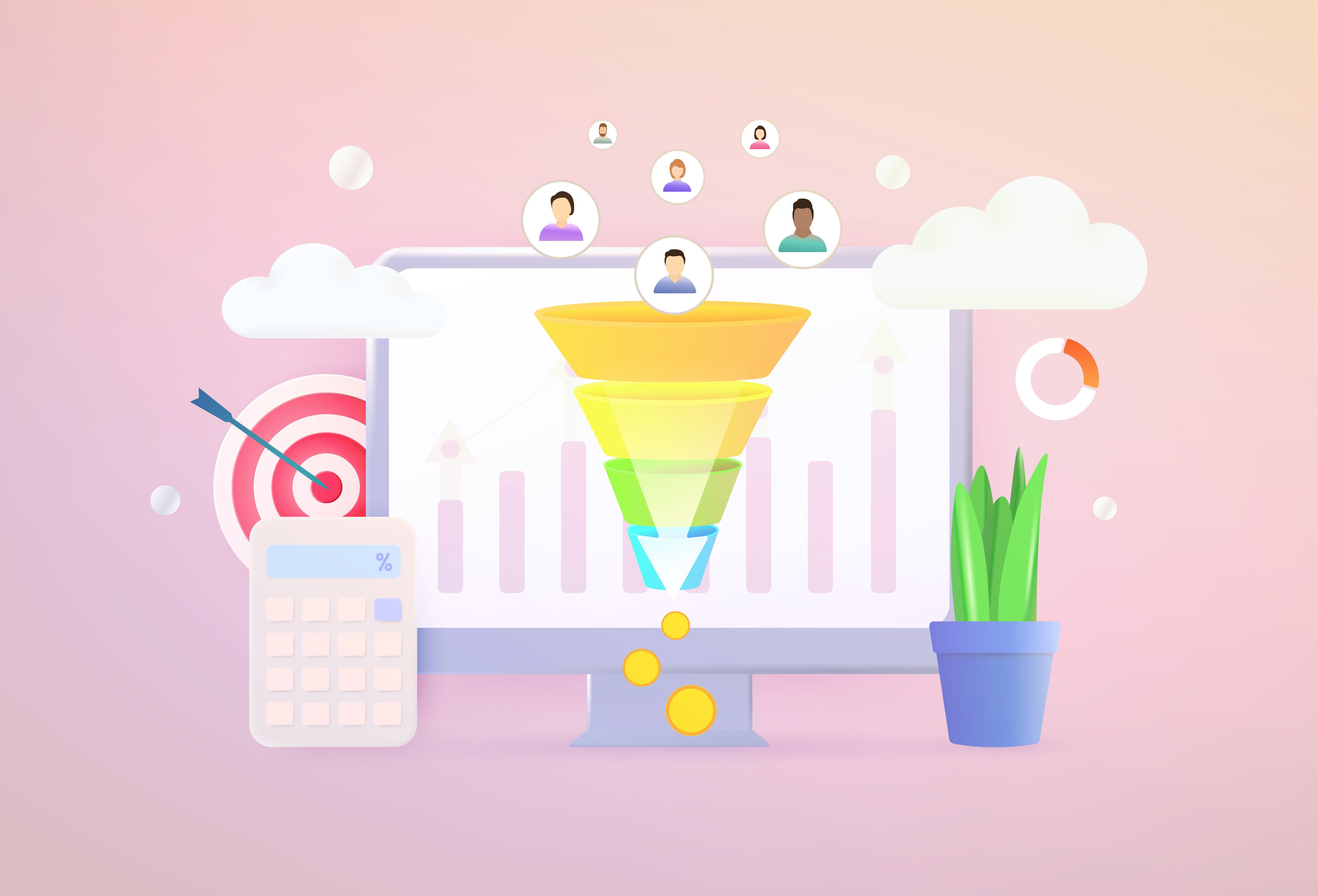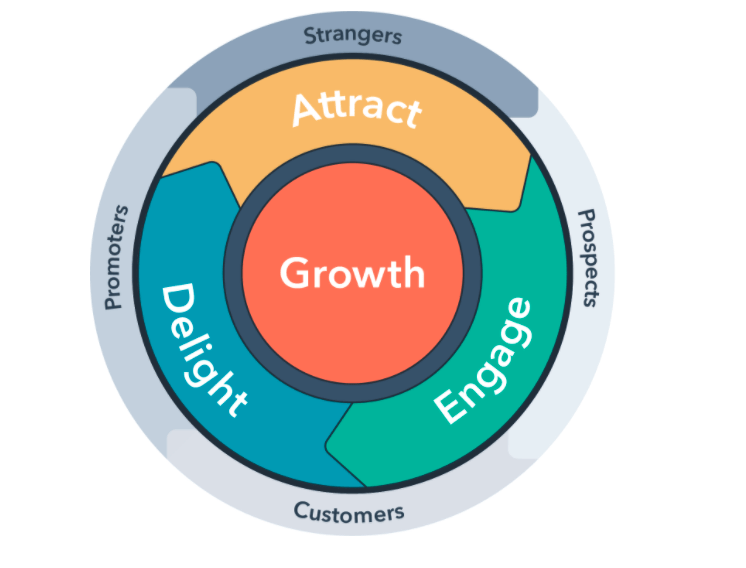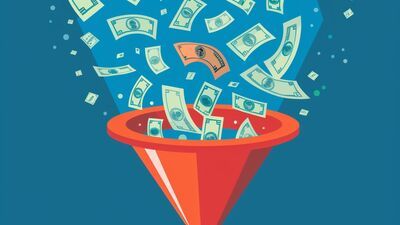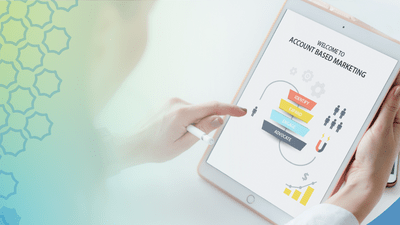B2B Inbound Marketing: Strategy Guide (+ 30 Proven Tips)

- B2B inbound marketing is cost-effective and builds long-term customer relationships throughout the buyer's journey.
- Implementing buyer personas and case studies can help tailor marketing strategies to your ideal customers and improve lead generation.
- Leverage a variety of inbound marketing types including content marketing, SEO, and social media to attract and convert potential clients.
- Utilize tools and strategies like landing pages, PPC, and KPIs to effectively measure and achieve marketing goals.
- Avoid common mistakes by setting clear goals, understanding your audience, and leveraging analytics to refine your approach.
Many businesses grapple with achieving sustainable and measurable growth through B2B inbound marketing, although some clearly excel — HubSpot itself is a great case study, as is its bountiful directory of successful case studies from other companies.
The challenges are numerous: poor lead generation, low conversion rates, and ineffective marketing tactics that fail to engage the target audience. When traditional outbound marketing methods fall short, how can your B2B company attract high-quality leads and convert them into loyal customers?
Here’s the reality: Businesses that focus solely on outbound marketing often miss the mark. Cold calling and PPC might bring immediate but short-lived results. To drive long-term success, you need a robust B2B inbound marketing strategy.
By leveraging some of the 30 hot tactics for B2B marketing covered in this article, new developments in AI, as well as taking advantage of the gold standards like SEO, content marketing, and social media platforms like LinkedIn, you can create a sustainable pipeline of high-quality leads.
Of course, this all needs to be guided by a well-crafted marketing strategy. Ready to boost your brand awareness, drive website traffic, and improve conversion rates? Let's get started on your journey to mastering B2B inbound marketing strategy.
What is B2B Inbound Marketing?
Why is it Important?
B2B or Business-to-Business marketing is a strategy to encourage people to come to your business for help. B2B inbound marketing is a type of marketing in which businesses use inbound marketing tactics to attract customers from other businesses.
B2B inbound marketing is important because it’s cost-effective, extremely efficient, and fits the scope and budgets of B2B companies quite well. Inbound marketing works to build intimate relationships with customers and nurtures them through every phase of the buyer’s journey.
Benefits
How Does Inbound Marketing Benefit B2B?
Inbound marketing benefits B2B companies and B2B buyers in diverse ways. First of all, it’s no secret that B2B sales cycles are long and frustrating, particularly in the healthcare industry. Inbound marketing makes the lengthy sales cycle more tolerable by helping customers faster in terms of communication and support.
As time goes by and content gets richer while buying committees get more complex, fewer and fewer people want to talk to a salesperson — and certainly not before they've done their due diligence, often via plenty of research and content consumption.
Continuously communicating a clear commitment and trust in the buyer’s journey helps build a strong foundation of trust between the customer and the business. The sales team also benefits from the power of relevant and quality content, produced by the content marketing teams. Furthermore, a business using inbound for B2B can save resources while benefitting from good traffic and quality lead generation, becoming even more efficient with the use of AI, especially generative AI.
Statistics
B2B Inbound Marketing Statistics
Understanding the impact of inbound marketing in the B2B sector can guide your strategy and help you make informed decisions. Here are some compelling statistics that highlight the effectiveness of B2B inbound marketing:

A staggering 80% of B2B companies use content marketing for lead generation. This shows a significant reliance on content as a primary tool for attracting potential customers. Additionally, 86% of B2B marketers use content to create brand awareness, emphasizing its role in building a recognizable and trustworthy brand presence.
Content marketing is also pivotal for generating demand and leads, with 70% of B2B marketers using it for this purpose. Furthermore, 68% of B2B marketers utilize content to nurture subscribers and leads, fostering long-term relationships with their audience. Interestingly, 63% of B2B marketers use content to build customer loyalty, highlighting the role of quality content in retaining clients.
When it comes to content types, the top three formats used by B2B marketers are blog posts (89%), email newsletters (81%), and social media content (81%). This diversity in content formats allows marketers to reach their audience through multiple channels and engage them in different ways.
The use of video content is also on the rise. In fact, the usage of video content among B2B marketers increased from 66% in 2022 to 75% in 2023. This trend underscores the growing importance of video as a medium for engaging and informing potential customers.
Interestingly, 47% of B2B buyers consume three to five pieces of content before engaging with a salesperson. This statistic highlights the importance of having a robust content strategy that provides valuable information throughout the buyer's journey. Additionally, 60% of people are inspired to seek out a product after reading content about it, and 84% expect brands to produce content, indicating high consumer expectations for informative and engaging content.
These statistics clearly illustrate the crucial role that content marketing plays in B2B inbound marketing strategies. By leveraging diverse content formats and focusing on delivering high-quality content, B2B companies can effectively engage their target audience, nurture leads, and build lasting customer relationships.
Close the Loop on Inbound Marketing Attribution
Discover how to tie every marketing effort to revenue with smarter attribution models and optimize for ROI across the funnel.
Important Inbound Marketing Models
The Sales Funnel Model

The sales funnel model is a visual model that a business’s sales team uses to understand the sales process in marketing.
The model breaks down every stage of the buyer’s journey. Some businesses might phrase or label their sales funnel differently, but here is a common structure that is used to show the stages. From top to bottom, the stages are:
- Awareness: The customer has found out about the business in question and the type of services they provide. The marketing efforts have paid off and gotten their attention.
- Discovery: The customer has found a product that looks intriguing. They have become a lead.
- Evaluation: The customer has weighed the pros and cons of purchasing the product. They have done their research and become a marketing-qualified leads. They have pondered whether they can afford the product or not.
- Intent: The customer has made the decision to purchase the product. They are now what’s referred to as a sales-qualified lead or SQL.
- Purchase: The customer has purchased the product of their choice.
- Loyalty: If satisfied, the customer knows that the business that sold them the product is competent and plans to buy from them again. They have probably written a review or fill out a survey to communicate their feelings about the product.
Ultimately your content marketing strategy should support the various stages of the buyer's journey.
The Flywheel Model
The flywheel model is a visual marketing model used in lead generation. It is similar to the sales funnel but shaped like a wheel instead of a funnel, with slightly different visualized principles.
The two models follow similar steps, however, the flywheel features three main principles that have a significant role in the inbound marketing methodology; attract, engage, and delight.

- Attract: You need to promote your brand enough to attract prospective customers. This is similar to the awareness category on the sales funnel model.
- Engage: At this point in the sales funnel, the customer is considering, evaluating, and forming a decision about the product. Engage them with any type of content tailored to their specific needs.
- Delight: By now, the customer has made their decision and purchased the product. They are a sales-qualified lead. After they have been delighted by the product and/or service, they have become a promoter.
Learn more about the FlyWheel model, developed by HubSpot, here.
To summarize, as each stage of the buyer’s journey, from awareness to loyalty, is completed, the relationship between the person and the business progresses from stranger to lead to customer to promotor, which leads to more strangers becoming leads, customers, and eventually promoters. As the cycle continues and the flywheel keeps circulating, the flow of revenue for the business is maintained.
5 Major Inbound Marketing Mistakes (and How to Avoid Them)
Here they are, folks:
Mistake #1: Not having clearly defined marketing goals:
Without fully formed business goals, your marketing team will be disorganized and struggle to achieve your desired growth.
You will have no idea who to reach out to or how to do so and will not know how to allocate your time or budget. This can harm your revenue stream, and your business will struggle to remain afloat.
Solution: SMART goals. These are specific, measurable, attainable, relevant, and time-based goals. This is a common, simple, and effective tool you can use to keep setting goals that you will remember and work to achieve.
Having SMART goals can help you with any number of things, from balancing workflows to adapting your content strategy. They will motivate you and increase your confidence in your marketing efforts.

Mistake #2: Not running enough tests:
Data is everything, and so is analyzing that data on a regular basis. If you don‘t test your website‘s performance, you will know nothing about the design flaws. Any piece of content that fails to satisfy your target audience and bring more B2B buyers is a liability.
Once the general swath of website visitors notice your failure to address the shortcomings that negatively affect their online experience, your website traffic, and lead generation will deteriorate.
Solution: Using online analytics tools to track website traffic and other important metrics will help you achieve this more easily. Google Analytics, Hotjar.com, SEMrush, HubSpot, and other services can do this for you sufficiently and quickly. The data you collect and analyze with these tools will help you evaluate what you currently have on the website and then produce more quality content.
Mistake #3: Not having a target audience to market to:
If you aimlessly produce work with nobody to tailor it to, your lead generation will suffer. This is especially true if your line of work is supposed to be inbound marketing.
If you are spinning out non-specific content devoid of further details, even digitally, your methodology is mirroring the outdated methodology of outbound marketing instead of the modernity of inbound marketing.
Solution: This is the reason why you need to create buyer personas. The personas will help you find your target audience, get to know them, and figure out how to tailor your business to them.
You will know how to personalize the emails you send, you will know what appealing quality content to put on your website, your lead generation will increase, and your relevance in the community will improve. The business will also thrive financially.
Mistake #4: Creating spam:
Spamming people’s inboxes is not going to pull them in but rather push them away. People find spam annoying and tend not to trust it, especially if they have been hacked in the past. Protect your reputation with customers by refraining from creating spam.
Solution: The alternative to creating spam, use regular, polite email marketing. It will feel like you are still spamming in the beginning, but the difference here is that you actually have a list of subscribers you can send these relevant and helpful emails.
Mistake #5: Ignoring Customers’ Pain Points:
Pain points are any of the problems faced throughout any stage of the buyer’s journey. In B2B, common pain points for the customer include feeling unsupported or uninformed, not getting their money’s worth from the product, or finding the buying process overly complicated.
Solution: Listen carefully to what a customer has to say. Their words are authentic, and they matter. Validate their concerns about navigating the marketplace and make sure to address and solve the issues they’ve been experiencing.
Make sure to keep communication between your business and the customers clear and constant. Thoroughly inspect and redesign your products to guarantee longevity and satisfaction. Make every stage of the buyer’s journey as simple and efficient as possible.
Creating High-Quality Content
Creating High-Quality Content for a B2B Inbound Marketing Strategy
Creating high-quality content is the cornerstone of a successful B2B inbound marketing strategy. Your content must resonate with decision-makers in B2B businesses, providing value and insights that address their specific challenges and needs. Here's how to create content that attracts and converts new customers.
1. Identify the Right Formats
Choosing the appropriate content formats is crucial for engaging your audience. Different formats resonate with different decision-makers. Consider including the following in your strategy:
- Blog Posts: Short to medium-length articles that address specific topics.
- Whitepapers and eBooks: In-depth resources that provide comprehensive information.
- Webinars: Interactive sessions that allow for real-time engagement.
- Templates: Practical tools that decision-makers can use immediately in their workflows.
- Infographics: Visual content that simplifies complex information.
2. Focus on High-Quality Content
High-quality content is not just about good grammar and spelling; it's about providing value. Your content should be well-researched, data-driven, and actionable. This is especially important for B2B businesses, where decision-makers expect reliable and insightful information.
- Research Thoroughly: Use reputable sources and include data and statistics.
- Provide Actionable Insights: Offer practical advice that your audience can implement.
- Optimize for SEO: Ensure your content is discoverable by search engines to attract organic traffic.
3. Leverage Social Media Marketing
Social media marketing is an effective way to distribute your high-quality content and reach a broader audience. Use platforms like LinkedIn, Twitter, and Facebook to share your content and engage with your audience.
- Share Consistently: Regularly post updates, articles, and infographics.
- Engage with Followers: Respond to comments and participate in discussions.
- Use Backlinks: Encourage shares and mentions to build backlinks, improving your content's SEO value.
4. Utilize CRM Tools for Personalization
CRM tools can help you tailor your content and marketing efforts to better meet the needs of your audience. By leveraging CRM data, you can create personalized content that resonates with different segments within B2B businesses.
- Segment Your Audience: Use CRM data to categorize your audience based on industry, job role, and interests.
- Personalize Content: Tailor your messages and offers to each segment.
- Track Engagement: Use CRM analytics to measure how decision-makers interact with your content.
5. Target Specific Verticals
If your products or services cater to SaaS companies, for example, ensure your content addresses their unique challenges and opportunities.
- Highlight Case Studies: Show how your solutions have benefited other SaaS companies.
- Offer Practical Solutions: Provide tips and strategies specific to the SaaS industry.
- Use Relevant Keywords: Ensure your content is optimized for terms frequently used by SaaS decision-makers.
By focusing on these practices, you can create high-quality content that not only attracts but also engages and converts decision-makers in B2B businesses. This holistic approach will help you build long-term relationships, driving sustainable growth and attracting new customers.
Supercharge Your Website Traffic with O8
Partner with our expert inbound marketing agency today to attract more visitors and grow your revenue.
30 Hot Tactics for B2B Inbound Marketing
Let's face it, people use the word "strategy" and "tactic" interchangeably. We're not here to change your mind about which is which. With that, here are 30 B2B marketing tactics (okay, they're tactics — not strategies) to help you dominate your market. They aren't all directly related to inbound, but can ultimately be connected to inbound campaigns. Hopefully these can serve as inspiration for your greater B2B inbound marketing strategy.
Actionable Tactics for B2B Inbound Marketing in 2024

1. Search Engine Optimization (SEO)
Search engine optimization (SEO) is one of the more lucrative inbound marketing strategies. That's because it can drive mass amounts of traffic by targeting highly relevant keyphrases across your entire B2B content funnel. Read more about SEO content optimization.
2. Lead Magnets and Free Resources
One of the best ways to attract more inbound leads is with free resources like ebooks, templates, quizzes, and calculators. For example, DesignFiles offers a full year of social media post prompts for their target audience of interior designers.
3. Email Nurture Sequences
After collecting leads with your lead magnets, nurture them with email sequences. As an example, TravelPerk sends an email after someone downloads their ebook on how to choose a business travel management solution.
4. Guest Blogging
Guest blogging can drive organic traffic, enhance your SEO efforts, and establish your authority within your niche. Learn more about scaling your content production here.
5. Account-Based Marketing (ABM)
Account-based marketing targets specific companies. Drift uses various strategies to target accounts, including creating dedicated landing pages. Here's an example page for investment company AllianceBernstein.
6. Virtual Events
Virtual events have become increasingly popular. For instance, Airmeet is hosting an upcoming event to discuss their concept of event-led growth and how it relates to content marketing.
7. Influencer Marketing
Partner with influencers who align with your audience. For instance, here's a post shared by HOME WORKOUTS・PILATES・WELLNESS (@blissedhappiness), showcasing Canva.
8. How-Tos and Tutorials
Provide how-to guides and tutorials that resonate with your audience. EasyBooks offers helpful steps in this example.
9. Employee Advocacy
Leverage the social audiences of your employees. For example, the head of content for Lavender discusses the core value of their tool in this LinkedIn post.
10. Affiliate Marketing
Set up an affiliate program and offer resources and templates to help affiliates. Check out StoryChief's affiliate program.
11. Proprietary Research Studies
Conduct your own research to offer high-value content. Proposify's annual State of Proposals report is a great example.
12. Product-Led Growth (PLG)
Use free trials and freemium business models to get new users. Check out the HubSpot landing page optimized for “free CRM software.” For more go-to-market motions, check out our article on the subject.
13. Native Social Media Content
Create more native content to get more visibility and engagement. For example, check out this LinkedIn post from Gong.
14. Podcast Tours
Share unique tips or ideas on different podcasts. SEO consultant Chima Mmeje discusses her topic cluster strategy on Empire Flippers and Rankable.
15. Content Repurposing
Repurpose your content in different formats. For instance, Bonjoro shares their custom message templates in various formats like a helpdesk article, blog post announcement, master class lesson, and YouTube video.
Additional B2B Inbound Marketing "Conceptual" Tactics
16. User-Generated Content Campaigns
Encourage customers to create and share content related to your brand or products. This builds social proof and expands your reach. For example, host a video contest asking customers to share how they use your product to solve business problems.
17. Webinars with Industry Experts
Partner with thought leaders in your industry to co-host webinars on relevant topics. This attracts a wider audience and positions your brand as a knowledge leader. For example, a B2B marketing platform could co-host a webinar with a renowned marketing strategist on the future of AI in marketing.
18. Interactive Assessments or Quizzes
Create online assessments that help potential customers identify their pain points or needs. This provides valuable insights and leads them towards your solutions. For example, a CRM software company could offer a "Sales Process Maturity Assessment" to help businesses evaluate their sales effectiveness.
19. Community Building on Niche Platforms
Engage with potential customers on industry-specific forums, Slack groups, or social media communities. Provide helpful advice and build relationships with key influencers. For example, a B2B SaaS company could actively participate in relevant subreddits or LinkedIn Groups to answer questions and share insights.
20. Customer Success Stories as Sales Collateral
Repurpose customer success stories into compelling sales enablement tools like one-pagers or slide decks. Use these to showcase the value of your product to potential clients. For example, a B2B software provider could create a visually engaging slide deck highlighting a customer's successful implementation and ROI.
21. Interactive Demos or Simulations
Offer virtual product demos or interactive simulations that allow prospects to experience the value of your product firsthand. For example, a software company could create a virtual sandbox environment where potential customers can test-drive their platform's features.
22. Co-Marketing Campaigns with Non-Competitors
Partner with complementary businesses to cross-promote each other's products or services to a wider audience. For example, a B2B marketing agency could partner with a sales consulting firm to offer a joint webinar on aligning marketing and sales strategies.
23. Executive Thought Leadership Content
Encourage company executives to publish articles or blog posts on LinkedIn or other industry platforms. This positions them as thought leaders and builds credibility for your brand. For example, a CEO could share their insights on industry trends or company culture on their LinkedIn profile.
24. Gamification in Marketing Campaigns
Incorporate elements of gamification, such as quizzes, challenges, or rewards, into your marketing campaigns to increase engagement and lead generation. For example, a B2B software company could create a quiz that tests prospects' knowledge of industry best practices and offers a discount on their product as a reward.
25. Personalized Chatbot Experiences
Implement AI-powered chatbots on your website to provide personalized responses to customer inquiries and guide them through the sales funnel. For example, a chatbot could ask qualifying questions to determine a prospect's needs and then recommend relevant products or services.
26. Virtual Reality (VR) or Augmented Reality (AR) Experiences
Offer immersive VR or AR experiences that showcase your products or services in a unique and engaging way. For example, a manufacturing company could use VR to give potential customers a virtual tour of their factory or product showroom.
27. Customer Advisory Boards
Create a customer advisory board to gather feedback and insights from your most valuable customers. This fosters a sense of community and helps you align your product development with customer needs. For example, a B2B software company could invite key customers to participate in a quarterly advisory board meeting to discuss product enhancements and industry trends.
28. Industry Awards and Recognition
Apply for industry awards or seek recognition for your company's achievements. This builds credibility and attracts positive attention to your brand. For example, a B2B marketing agency could submit their work for consideration in industry award programs or seek accreditation from relevant organizations.
29. Account-Based Advertising
Use targeted advertising platforms to reach specific individuals or accounts within your target audience. This ensures your message is seen by the right people at the right time. For example, a B2B software company could use LinkedIn Ads to target decision-makers at specific companies with personalized messaging.
30. Cause Marketing Campaigns
Partner with a non-profit organization or social cause that aligns with your brand values. This demonstrates social responsibility and resonates with purpose-driven consumers. For example, a B2B tech company could partner with a charity focused on STEM education to offer mentorship programs or donate a portion of their profits.
By integrating these 30 comprehensive tactics into your B2B inbound marketing strategy, you can effectively attract, engage, and convert high-quality leads, ensuring sustainable growth and maintaining a competitive edge in your industry.
Drive More Website Traffic with O8
Team up with our inbound marketing experts today to attract, engage, and convert your ideal audience.
The Basics of B2B Inbound Marketing Strategy
Core Strategies and Tools
Core B2B Inbound Marketing Strategies and Tools
Buyer Personas: Creating buyer personas can help you with finding and marketing toward your ideal customers. When creating these personas, include age, location, occupation, interests, and demographics.
Case studies: Performing case studies to a great way to collect data that you and your marketing team can use to your advantage. This can be data on your target audience, on the marketing industry in general, competing businesses, and customer satisfaction. You can use this data to gain more qualified leads and produce more great content.
Landing pages: A landing page is a webpage that is reached by clicking on an email, ad, or link. You will find a Call to Action (CTA) on a landing page. For example, if a potential customer shows interest in signing up for a mailing list, they can use the landing page to complete that action. From there, they can receive more emails and eventually buy from the business if they want to.
PPC: Pay Per Click, or PPC, is another clever tactic that helps you basically buy customers instead of trying to rely too much on organic website traffic. PPC is a digital advertising model in which an ad publisher gets paid a fee every time one of their ads gets clicked by someone on the internet. If SEO and PPC have been used, a website could be the first to appear when a certain keyword is searched, which also accelerates lead generation.
CTA: A Call to Action (CTA) is a written directive that marketers use to guide users to a specific place. Examples of CTAs include social media ads, hyperlinks, and buttons that say Buy Now, Subscribe Shop Here, or Download. These can be found on landing pages, blogs, etc — all across the website. For some reason, B2B companies tend to be bad at writing and incorporating well-crafted CTAs. CTAs give customers the chance to go ahead and buy products or get access to more information that can help them during other stages of the buyer’s journey.
KPIs: Key Performance Indicators, or KPIs, are also commonplace in the digital marketing world. These are metrics that are used to measure the success of your marketing efforts. Examples of KPIs include revenue, marketing qualified leads (MLQs), sales qualified leads (SQLs), customer retention, conversion rate, return on investment (ROI), and organic traffic.
Types of Inbound Marketing
Yes, there are different types of inbound marketing, each focusing on specific strategies and content types to attract and engage potential customers. Here are some key types:
1. Content Marketing
- Blog Posts: Regularly updated articles that provide valuable information related to your industry, addressing common questions or problems.
- Ebooks and Whitepapers: In-depth, downloadable content that provides detailed information on a particular topic, often used to capture leads.
- Case Studies: Detailed examples of how your products or services have helped customers achieve their goals.
- Infographics: Visual representations of data or information that are easy to digest and share.
2. SEO (Search Engine Optimization)
- On-Page SEO: Optimizing individual web pages to rank higher in search engines, focusing on elements like keywords, meta descriptions, and internal linking.
- Off-Page SEO: Building backlinks and increasing the authority of your website through external methods.
- Technical SEO: Enhancing the backend structure of your website to improve its performance and ensure it is easily crawlable by search engines.
3. Social Media Marketing
- Organic Social Media: Posting and engaging with your audience on social media platforms without paid promotion.
- Paid Social Media: Using paid advertisements on social media to amplify reach and engagement.
4. Email Marketing
- Newsletters: Regular updates sent to your email list to keep them informed about your business and industry trends.
- Drip Campaigns: Automated series of emails sent based on user behavior to nurture leads through the sales funnel.
- Promotional Emails: Emails focused on promoting specific products, services, or events.
5. Video Marketing
- Explainer Videos: Short videos explaining how your products or services work.
- Webinars: Live or recorded online seminars providing in-depth information on a specific topic.
- Product Demos: Videos showcasing the features and benefits of your products or services.
6. Webinars and Online Events
- Educational Webinars: Sessions focused on providing valuable insights and education on topics relevant to your audience.
- Q&A Sessions: Interactive webinars where you answer questions from your audience in real-time.
7. Podcasts
- Educational Podcasts: Audio content providing valuable information and insights on industry-related topics.
- Interview Podcasts: Episodes featuring interviews with industry experts, thought leaders, or satisfied customers.
8. Interactive Content
- Quizzes and Surveys: Engaging tools that provide personalized feedback or insights based on user responses.
- Calculators and Tools: Interactive features that help users calculate or estimate something relevant to their needs.
9. Influencer Marketing
- Collaborations: Partnering with industry influencers to co-create content or promote your brand.
- Sponsored Content: Paying influencers to create and share content about your products or services.
10. Online Communities and Forums
- Branded Communities: Creating and managing your own community where users can discuss topics related to your industry.
- Participation in External Communities: Engaging in discussions on external forums and social media groups.
11. Case Studies and Testimonials
- Success Stories: Highlighting how your solutions have helped clients achieve their goals.
- Customer Testimonials: Sharing positive feedback from customers to build trust and credibility.
12. Paid Search and Social Ads
- Search Engine Ads: Paid advertisements that appear in search engine results.
- Social Media Ads: Targeted advertisements on social media platforms designed to attract and engage potential customers.
By leveraging these various types of inbound marketing, businesses can create a well-rounded strategy that attracts, engages, and converts potential customers at different stages of their buyer journey.
At O8, we help clients with all of the above. See our services for more information.
Case Studies
B2B Inbound Marketing Case Studies
When it comes to implementing a successful B2B inbound marketing strategy, real-world examples can offer invaluable insights and inspiration. Here, we explore six compelling case studies where businesses across various industries have leveraged inbound marketing techniques to achieve remarkable results.

These stories showcase how companies have utilized tools like HubSpot to streamline their processes, enhance customer engagement, and drive measurable growth. Whether you're looking to boost lead generation, improve customer retention, or optimize your marketing automation, these case studies highlight proven strategies that you can adapt to your own B2B marketing efforts.
- Recreational Group
- Industry: Manufacturing
- Challenge: Boosting marketing efforts.
- Solution: Utilized HubSpot App Marketplace and integration tools.
Results: Enhanced inbound marketing strategies, leading to better engagement and business growth.
- Santagostino
- Industry: Healthcare
- Challenge: Increasing leads.
- Solution: Implemented HubSpot for an omnichannel customer experience.
Results: Significant lead increase and improved overall customer experience.
- LucaNet
- Industry: Software & Technology
- Challenge: Centralizing global marketing automation.
- Solution: Adopted HubSpot to integrate company data and streamline processes.
Results: More efficient global marketing strategies and improved operational efficiency.
- Booxi
- Industry: Software & Technology
- Challenge: Aligning teams across continents and reducing costs.
- Solution: Used HubSpot to boost sales and reduce customer churn.
Results: Saved $100k/year and improved team alignment.
- HungryHungry
- Industry: Software & Technology
- Challenge: Reducing customer onboarding time.
- Solution: Implemented HubSpot Apps and Service Hub for data integration.
Results: Halved customer onboarding time and enhanced data management.
- Swapfiets
- Industry: Consumer Services
- Challenge: Improving service and scaling support.
- Solution: Leveraged HubSpot Service Hub.
Results: Significantly shortened response times and improved customer care.
These case studies highlight how different businesses have successfully used HubSpot's inbound marketing tools to tackle various challenges, driving growth and efficiency in the B2B sector.
FAQs
What is the Difference Between Inbound and Outbound Marketing?
Outbound marketing is when the business focuses on outreach to potential customers without having a well-defined target audience, capturing any attention they get. Outbound marketing is a traditional method, that many in this day and age would consider outdated and less effective.
Examples of outbound marketing tactics would be cold calling and putting up billboards. Inbound marketing, on the other hand, is when the business lets potential customers from their target audience come to them. They achieve this by making information more accessible, presenting it resourcefully and clearly, and allowing potential buyers to do their own research and make the most informed decision.
Inbound marketing is more modern and has proven itself to be more effective due to the agile ability to adapt to technological evolutions. It thrives on digital marketing tactics and is beneficial to both B2B and B2C marketing campaigns across the board.
Conclusion
The most important takeaway from this is that you are probably already quite familiar with a lot of the information in this article, and now you know other ways to apply it. All these different marketing structures, types, and strategies often overlap with one another, and they are all worth knowing so you can be prepared for anything your business experiences.
Hopefully, thanks to this article, you have a deeper understanding of what defines an inbound marketing structure, why it’s effective, and how it’s compatible with B2B. You know how to use various inbound marketing strategies across multiple marketing channels and how to keep your momentum going during customer interactions and sales.
Most importantly, you know how to stay relevant, and no matter the business, product, or platform, relevance is what a customer needs to see from you first.








